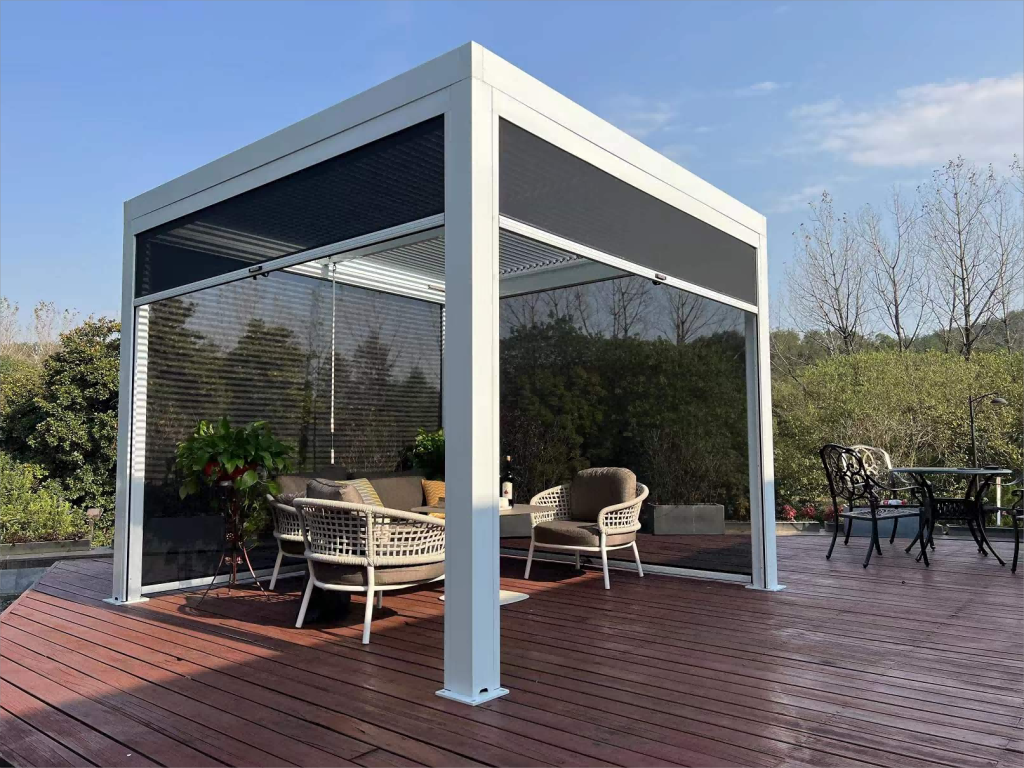The concept of a foundation is fundamental to construction, as it ensures stability and durability for various structures. When considering the need for foundations, waterproof pergolas present a unique case. Typically used in gardens or as extensions of homes, pergolas serve both aesthetic and functional purposes. This article delves into the intricacies of whether pergola need foundations, examining different factors such as material, ground conditions, and installation methods to provide a comprehensive understanding of this topic.
Understanding Pergolas
A pergola is an outdoor garden feature forming a shaded walkway, passageway, or sitting area of vertical posts or pillars that usually support cross-beams and a sturdy open lattice. The lattice can support climbing plants, adding to the charm and utility of the structure. Pergolas can be freestanding or attached to a building, and they can be made from various materials including wood, metal, and vinyl.
Material Considerations
Aluminum Pergolas
Aluminum pergolas are known for their durability and low maintenance. They undergo special processes during production, such as extrusion and spraying, which enhance their strength. Aluminum’s resistance to rust and corrosion makes it an ideal choice for outdoor structures. The inherent strength of aluminum allows for robust construction without the need for heavy foundations, especially when installed on solid ground.
Wooden Pergolas
Wooden pergolas, traditionally made from materials like cedar, redwood, or pressure-treated lumber, have a natural and rustic appeal. However, wood is susceptible to rot, insect damage, and weathering over time. Wooden pergolas often require more substantial foundations to prevent ground contact and moisture infiltration, which can compromise the structure’s integrity.

Vinyl Pergolas
Vinyl pergolas are another low-maintenance option, offering resistance to weather and pests. While lighter than aluminum, vinyl pergolas still benefit from being anchored securely to prevent movement during strong winds or storms. The material’s flexibility necessitates careful consideration of the installation surface and potential foundational support.
Ground Conditions
The stability and type of ground where a pergola is to be installed significantly influence whether a foundation is necessary.
Stable Ground
On stable, flat surfaces such as concrete patios or decks, pergolas can often be installed without traditional foundations. The posts of the pergola can be fixed directly to the surface using brackets and anchors. This method provides sufficient stability for the structure, especially in environments with minimal soil movement or shifting.
Soft or Unstable Ground
In areas where the soil is soft, sandy, or prone to shifting, additional foundational support may be required. Without a stable base, the pergola could lean, sink, or become unstable over time. In such cases, embedding the posts into the ground and securing them with concrete footings can provide the necessary support to ensure long-term stability.
Sloped Terrain
For pergolas installed on sloped terrain, foundations become even more critical. The slope can create uneven pressure on the structure, increasing the risk of tilting or collapse. To address this, posts may need to be embedded deeper on the lower side of the slope and supported with retaining walls or other structural reinforcements.
Installation Methods
The method of installation plays a crucial role in determining the need for a foundation.
Freestanding Pergolas
Freestanding pergolas can be a focal point in gardens, patios, or other outdoor spaces. They do not rely on attachment to an existing structure for stability. For freestanding pergolas, the choice of foundation depends largely on the ground conditions. On solid, level surfaces, they can often be installed using surface-mounted brackets. However, in less stable conditions, concrete footings or pilings may be necessary to ensure the pergola remains upright and secure.

Attached Pergolas
Attached pergolas are connected to a building, providing additional support and stability. This type of pergola benefits from the structural integrity of the building it is attached to, reducing the need for extensive foundations. However, the posts that are not attached to the building still require a secure base. Depending on the ground conditions, this could involve surface-mounted brackets or embedded posts with concrete footings.
Foundation Types
When a foundation is deemed necessary for a pergola, several types can be considered:
Concrete Footings
Concrete footings are one of the most common foundation types for pergolas. They involve digging holes at the base of each post, filling them with concrete, and embedding the posts into the concrete. This method provides a solid anchor for the pergola, ensuring stability and resistance to movement.
Surface-Mounted Brackets
Surface-mounted brackets are used when the pergola is installed on a stable, flat surface like a concrete patio or deck. The brackets are anchored to the surface with bolts, and the pergola posts are then attached to the brackets. This method is less invasive than concrete footings and is suitable for environments where soil conditions are not a concern.
Ground Spikes
Ground spikes are a simpler alternative for lighter pergolas, particularly in garden settings. These metal spikes are driven into the ground, and the pergola posts are then inserted into the spikes. While not as stable as concrete footings, ground spikes can provide adequate support for smaller structures in stable soil conditions.
Structural Integrity and Safety
Ensuring the structural integrity and safety of a pergola is paramount. A well-constructed pergola not only enhances the aesthetics of an outdoor space but also provides a safe and secure environment for relaxation and entertainment.
Load-Bearing Considerations
Pergolas, especially those designed to support climbing plants or additional shading materials, must be able to bear significant weight. The foundation must be capable of supporting this load without shifting or sinking. This is particularly important in areas prone to heavy rainfall or high winds, where additional weight from wet foliage or wind pressure can strain the structure.
Wind Resistance
In regions with high wind speeds, the risk of a pergola becoming a hazard increases if it is not securely anchored. A strong foundation helps prevent the pergola from being uplifted or toppled by gusts. Wind bracing and securely anchored posts are essential components in wind-resistant pergola design.
Seismic Considerations
In earthquake-prone areas, the foundation design for a pergola must take seismic activity into account. Flexible connections and deeper footings can help absorb seismic forces, reducing the risk of structural damage during an earthquake.
Environmental Impact and Sustainability
The environmental impact of constructing a pergola and its foundation should also be considered. Sustainable practices in construction can reduce the ecological footprint and promote environmental responsibility.
Material Selection
Choosing sustainable materials for both the pergola and its foundation is an important step. Recycled aluminum, sustainably sourced wood, and eco-friendly concrete mixes can reduce the environmental impact of the structure.
Minimizing Ground Disturbance
Minimizing ground disturbance during installation helps preserve the natural landscape and prevent soil erosion. Using surface-mounted brackets instead of digging extensive footings can achieve this, especially in sensitive environments.
Case Studies and Examples
Examining real-world examples can provide insights into the practical application of foundational principles for pergolas.
Urban Patio Pergola
In an urban setting, a homeowner installed a pergola on their concrete patio. Due to the stable surface, they used surface-mounted brackets to secure the posts. This method provided sufficient stability without the need for invasive groundwork, preserving the patio’s aesthetic while ensuring the pergola remained secure.
Rural Garden Pergola
In a rural garden with softer soil, a freestanding pergola was installed to support climbing roses. The posts were embedded into concrete footings to prevent shifting and tilting. Despite the additional effort and cost, the concrete footings ensured the pergola could support the weight of the plants and withstand varying weather conditions.
Coastal Deck Pergola
A coastal home featured a pergola over a wooden deck. Given the exposure to high winds and saltwater, the pergola was attached to the house for added stability. The posts on the outer edge of the deck were anchored with heavy-duty brackets and additional cross-bracing to resist wind forces. This combination provided a stable and durable structure suitable for the coastal environment.
Maintenance and Longevity
The longevity of a pergola is directly influenced by its foundation. Regular maintenance and inspections can help identify potential issues early and prolong the life of the structure.
Regular Inspections
Conducting regular inspections of the pergola and its foundation can help identify signs of wear, movement, or damage. Checking for cracks in concrete footings, corrosion in metal brackets, and rot in wooden posts can prevent small issues from becoming major problems.
Protective Measures
Applying protective treatments to wooden posts, using rust-resistant coatings on metal components, and ensuring proper drainage around the base of the pergola can enhance its durability. These measures help protect the foundation from environmental factors that can degrade its integrity over time.
Conclusion
In conclusion, whether a pergola needs a foundation depends on various factors including the material of the pergola, ground conditions, installation method, and environmental considerations. Aluminum pergolas on stable concrete surfaces may not require traditional foundations, while wooden or vinyl pergolas on softer or sloped ground may need concrete footings for stability.
The method of installation—freestanding or attached—also influences the need for a foundation. Freestanding pergolas in particular may require more substantial foundations to ensure they remain secure over time.
Ultimately, ensuring the structural integrity and safety of a pergola is crucial, and proper foundational support is a key component. By considering the specific conditions of the installation site and using appropriate foundational techniques, homeowners can enjoy a beautiful, durable, and safe pergola that enhances their outdoor space.
Moreover, adopting sustainable practices and materials can reduce the environmental impact of pergola construction, contributing to a more eco-friendly approach to outdoor living spaces. Regular maintenance and proactive measures further ensure the longevity and stability of the pergola, providing years of enjoyment and aesthetic appeal.



You have noted very interesting details! ps decent website.Expand blog